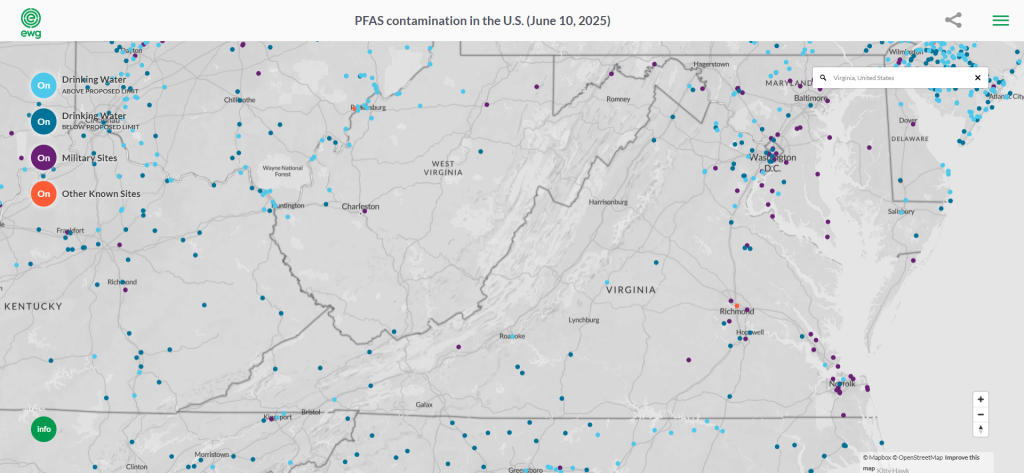- Home
- Personal Injury
- PFAS Lawsuit
- PFAS Contamination Map
- PFAS in Virginia
PFAS in Virginia
- Last updated: July 16, 2025
-
Contributor: nicky

I have noticed growing public concern over “forever chemicals” known as per- and polyfluoroalkyl substances, or PFAS. In reviewing PFAS Virginia data from government agencies and advocacy groups, I see how deeply this issue touches our water systems, our farmlands, and our personal health. Because these chemicals can remain in the environment indefinitely, communities across the state are seeking clarity on potential health impacts and legal options. My aim is to provide a fact-based overview of what PFAS are, where they’re found, the associated risks, and what steps Virginia is taking to address contamination.
What are PFAS and why are they dangerous?
PFAS refers to a large group of human-made chemicals that have been in use since the mid-20th century. Manufacturers often adopt PFAS for products that repel oil, water, and stains, including nonstick cookware, firefighting foams, and water-resistant fabrics.
The trouble begins when PFAS enter our environment through wastewater, industrial processes, or accidental releases. Because PFAS do not break down easily, they can persist in groundwater, soil, and the food chain. Research funded by the Water Research Foundation, as well as studies from the Centers for Disease Control and Prevention (CDC), has shown potential links between prolonged PFAS exposure and adverse health outcomes, including cancers, immune-system issues, and developmental delays in children. For those of us living in areas with known PFAS contamination, the concerns are especially pressing.
Where are PFAS found in Virginia?
From my review of state documents, I learned that PFAS hotspots in Virginia include industrial zones, older military installations, and areas near airports. This is consistent with evidence that firefighting foams containing PFAS were historically used in training exercises on certain bases and airfields. Residential regions downstream from these sites often end up with higher PFAS levels in their drinking water.
The Virginia Department of Environmental Quality (DEQ) has identified 28 drinking water systems exceeding advisable PFAS levels for at least one of the compounds. Rural and agricultural communities face special challenges, where contamination may affect farmland and livestock. Farmers I spoke with, as well as watermen in tidewater regions, are worried that PFAS may compromise their market access if contamination levels are deemed unsafe.
PFAS in Virginia’s drinking water
I have been following news about the state’s public water systems, including how they handle PFAS detection and remediation. Municipalities of varying sizes report heightened PFAS levels in their source water, prompting a need for consistent testing and potential regulatory enforcement. Understanding which communities and water providers are most affected helps clarify the scope.
Affected communities and water providers
According to announcements by the Virginia DEQ, about 10 to 12 public water systems in the state will be prioritized for source evaluations. These systems serve rural towns, suburban areas, and certain industrial corridors. Recurring concerns arise near runoffs from airports or facilities that used firefighting foams, such as certain military bases in the Hampton Roads region. Even private wells in some rural communities occasionally test above recommended PFAS thresholds.
In my view, the lack of uniform statewide data until recently made it hard for individual households to understand their risks. While a majority of drinking water systems in Virginia still meet federal guidelines, repeated exceedances in some areas highlight why improved monitoring is necessary.
Virginia Department of Health (VDH) and EPA testing data
VDH coordinates with the U.S. Environmental Protection Agency (EPA) to assess PFAS levels. Since April 2024, when the EPA finalized Maximum Contaminant Levels (MCLs) for certain PFAS, Virginia has stepped up its sampling and enforcement. Public records indicate 28 water systems were flagged for elevated PFAS as of September 1, 2024. Those systems have been notified, and additional notifications are planned for early 2025.
VDH maintains that monitoring compliance is crucial, especially as the state moves toward enacting its own PFAS regulations. I gathered that the Virginia State Water Board is also updating thresholds for several PFAS types to match or exceed new federal standards. This alignment process allows the state to take more direct action if levels rise beyond the recommended limits.
Military base and airport runoff contamination
Past trainings involving aqueous film-forming foam (AFFF) have been confirmed as a significant contributor to PFAS contamination near certain bases. Runoff from training sites can migrate into the water table and eventually reach municipal supplies. Airports face the same challenges, particularly where foam-based drills were routine. The combination of chemical spill risks and older infrastructure intensifies contamination concerns.
Independent testing commissioned by local communities near some of these bases has found PFAS levels exceeding the EPA’s health advisory in both soil and local water sources. While the Department of Defense has initiated cleanup efforts at selected bases statewide, many see these moves as interim measures that won’t fully address the deeper contamination until further research is done.
PFAS in Virginia’s soil and agriculture
I spoke with farmers who depend on wells or surface water for irrigation. Their concerns revolve around PFAS-laden water seeping into the soil, potentially affecting crops and livestock. When contamination levels are high enough, it disrupts export markets, as buyers want reassurance that produce or livestock products are free of chemical residues.
Based on information published by the Virginia DEQ, certain counties in the Chesapeake Bay watershed are particularly vulnerable due to industrial runoffs. Aquaculture and shellfish farming around the Bay face uncertain markets if PFAS contamination is confirmed at levels that surpass safety guidelines. In one example, early tests in the Eastern Shore region prompted additional sampling to ensure local aquaculture remained compliant with health advisories.
Health effects of PFAS exposure
I have reviewed relevant scientific literature to understand PFAS health implications. While research continues, scientists generally agree on potential links between PFAS exposure and:
Increased risk of certain cancers, including kidney and testicular
Immune-system impairment, with possible impacts on vaccine response
Liver problems, such as elevated cholesterol or signs of damage
Reproductive and developmental issues, particularly in pregnant mothers and children
However, there is nuanced debate over the precise levels of PFAS that trigger these effects. Exposures vary depending on one’s occupation, place of residence, and local water source. According to the CDC, most Americans have some PFAS in their blood, but those living near contamination hotspots might experience higher-than-average levels. Ongoing public-health studies and epidemiological research aim to determine how much exposure leads to adverse outcomes, especially among sensitive groups like children.
PFAS-linked diseases in Virginia
I notice increasing community-driven research correlating elevated PFAS levels and certain diseases. While the data is evolving, state health authorities and academic researchers agree that several serious health conditions could have stronger associations with PFAS when exposures occur over time.
Kidney cancer
Some epidemiological studies point to a possible relationship between chronic PFAS exposures and kidney cancer. PFAS can accumulate in the kidneys because the body struggles to break down these chemical bonds. As a result, long-term, low-dose exposure may escalate potential risks. Civil-society groups in Virginia have urged more localized studies to see if specific PFAS hotspots track higher kidney cancer rates.
Testicular cancer
Studies funded by the National Institute of Environmental Health Sciences have noted potential correlations between PFAS exposure and testicular cancer. In Virginia, certain clusters of testicular cancer cases near historic industrial sites have prompted additional scrutiny. Researchers caution that confounding factors, such as genetic predispositions or other environmental toxins, can complicate findings. However, heightened community awareness has led to calls for better testing and screening.
Thyroid disease
Thyroid disorders, which affect metabolism and overall hormone balance, have also been associated with PFAS in some scientific investigations. For individuals with low-level but prolonged contact (often through contaminated drinking water), subclinical changes in thyroid hormones could accumulate. The Virginia Department of Health advises regular check-ups for anyone who suspects PFAS in their home water supply or experiences unusual symptoms consistent with thyroid dysfunction.
Liver damage and cholesterol changes
Laboratory and animal-based studies suggest that PFAS interference in liver function can lead to elevated cholesterol levels. Researchers have observed changes in rodents’ liver enzymes that mirror early signs of damage. Translating these findings to humans has proven more challenging, but some human population studies corroborate higher cholesterol readings in communities with increased PFAS exposure. If, like me, you regularly have your cholesterol checked, it may be worth noting potential environmental factors behind any abnormal results.
How Virginia is responding to the PFAS crisis
In recent years, Virginia’s response has included legislative initiatives, regulatory proposals, and inter-agency cooperation to tackle PFAS contamination. I’ve kept an eye on the evolving regulatory environment and the specific measures aimed at identifying PFAS sources and limiting future releases.
Virginia Department of Environmental Quality (DEQ) actions
DEQ began formal investigations into PFAS contamination in April 2024 when updated federal MCLs took effect. The agency is focusing resources on 10 to 12 high-priority public water systems. Officials plan to audit industrial dischargers and issue notifications to facilities deemed potential PFAS contributors.
Legislation passed by the Virginia General Assembly has encouraged the DEQ to propose amendments that match or exceed existing federal PFAS guidelines. Public hearings will be held, allowing those of us who drink from local water systems to voice concerns and track regulatory developments closely.
Statewide PFAS workgroup and water testing
A statewide PFAS workgroup, comprising state officials, health experts, and environmental advocates, coordinates water testing and risk communication efforts. Since the summer of 2022, the DEQ, the Virginia Department of Health, and regional water authorities have collaborated to trace PFAS contamination to industrial sources. One well-known case occurred in Roanoke County, where GenX, a type of PFAS, was traced back to an industrial user discharging into local wastewater facilities.
To maintain consistency, the workgroup has adopted a standardized testing protocol so that PFAS data from different localities can be compared. Such efforts aim for transparency and build trust as more people learn about PFAS in their local environment.
Federal and state remediation efforts
The EPA has allocated $27.2 million in Bipartisan Infrastructure Law funding to help Virginia address emerging contaminants like PFAS in drinking water. These grants support technologically advanced filtration systems, pilot projects to neutralize PFAS at the source, and ongoing water-quality monitoring.
At the same time, Virginia is implementing its own programs. Chapter 650 of the 2025 Virginia Acts of Assembly (HB 2050) established the Occoquan Reservoir PFAS Reduction Program, specifically targeting PFAS levels in a critical public water supply. Once the new state regulations align with federal MCLs, officials anticipate more robust enforcement, including mandatory disclosures and remediation plans for areas that test above recommended limits.
Can you test your water or soil for PFAS in Virginia?
If you own a private well or want to test your property’s soil, accredited environmental labs offer PFAS testing services. These tests analyze water or soil samples to detect specific PFAS compounds. Some county health departments also provide instructions or resources for residents to gather samples. However, testing procedures can be complex and somewhat costly, so it helps to contact professionals who are properly trained.
As I looked into test pricing and sample requirements, I found that many labs recommend sampling techniques that prevent cross-contamination, such as single-use gloves and PFAS-free water containers. If results confirm elevated PFAS, it may be possible to install specialized filtration systems or, in some severe cases, switch to an alternative water source.
Do you qualify for a PFAS lawsuit in Virginia?
Certain individuals who have experienced documented PFAS exposure from a known source, alongside severe health impacts, may qualify for legal recourse. If a property’s value has declined because of contamination, or if you or a loved one were diagnosed with a PFAS-linked illness, you could potentially file a claim. Legal actions often target chemical manufacturers, product distributors, or polluters thought to be responsible for releasing PFAS into a community’s water supply.
Although Virginia has not employed PFAS litigation as aggressively as some other states, a growing number of residents and businesses are exploring lawsuits. By documenting exposure, seeking medical reviews, and connecting with specialized attorneys, you can clarify whether legal action is a worthwhile path. If a settlement or court decision holds polluters accountable, compensation may be available for medical bills, property damage, and related costs.
Why choose Legal Claim Assistant
I believe that pursuing a PFAS claim requires guidance from a knowledgeable team. Legal Claim Assistant is dedicated to bridging the gap between individuals with legitimate claims and experienced attorneys who focus on PFAS litigation. By using their guidance, you gain:
Access to a network of lawyers well-versed in PFAS contamination laws
A free case review that evaluates whether you qualify for a lawsuit
Step-by-step support gathering proof of exposure and medical documentation
A clear communication process that updates you on case progress
To learn more or to see if you qualify, visit their PFAS Lawsuit page at Legal Claim Assistant. If you have specific questions about water contamination cases, you can also review this dedicated page or their DuPont lawsuit overview.
Frequently asked questions (FAQ)
Many Virginia residents ask me about testing, remediation, and legal options. Below are concise answers based on available data and ongoing state and federal efforts.
PFAS have been found in multiple municipal water systems, particularly those near industrial zones, military bases, or airports. According to the Virginia DEQ, 28 drinking water systems exceeded PFAS recommendations as of late 2024. Rural communities sometimes detect PFAS in private wells, especially if located near historical foam-use sites or manufacturing facilities.
If you are curious about PFAS presence in neighboring regions, you can consult resources. Ongoing testing across state lines helps us confirm how widespread contamination is.
Yes, you can hire specialized labs that perform certified PFAS tests. If you rely on a private well, the Virginia Department of Health and local health agencies recommend testing if you suspect contamination. Public water users can check local water-quality reports or contact their utility for PFAS-related data.
The state passed laws requiring enhanced monitoring, such as the new PFAS regulations aligning with the EPA’s Maximum Contaminant Levels. Virginia officials also conduct site inspections, issue notices for potential polluters, and coordinate cleanup efforts with the EPA. Funding from the Bipartisan Infrastructure Law is earmarked for research and treatment technologies to mitigate PFAS in public water systems.
Some farms near contaminated water sources have detected PFAS in soil or irrigation systems. Elevated PFAS might hinder livestock and crop sales if contamination is severe. However, not all farms are impacted to the same degree. Ongoing monitoring by the DEQ, combined with farm-level testing, aims to ensure that produce and livestock meet health and safety standards before entering the marketplace.
Chronic PFAS exposure may be associated with higher risks of kidney and testicular cancers, thyroid disorders, and immune dysfunction. Research also suggests possible cholesterol increases, particularly in communities with extensive exposure. While the precise danger level of PFAS remains a subject of scientific debate, multiple public-health agencies caution that reducing exposure is prudent, especially for vulnerable populations like children and pregnant women.
You might be eligible to file a lawsuit if you can demonstrate that your health or property was harmed by PFAS contamination, and if you can identify the responsible party. Companies that knowingly discharged PFAS, sold firefighting foams, or contributed to contamination through their operations have been the primary targets of these suits. I encourage you to consider a free case review from Legal Claim Assistant to see whether your situation meets the typical criteria.
Legal Claim Assistant specializes in connecting individuals with legal professionals who can investigate exposure pathways and advise on next steps.
Overview PFAS contamination in the USA
Here you van find the PFAS watercontamination map of the United States. Find, state by state, where water contamination has occurred due to PFAS exposure.
- PFAS in Alabama
- PFAS in Alaska
- PFAS in Arizona
- PFAS in Arkansas
- PFAS in California
- PFAS in Colorado
- PFAS in Connecticut
- PFAS in Delaware
- PFAS in Florida
- PFAS in Georgia
- PFAS in Hawaii
- PFAS in Idaho
- PFAS in Illinois
- PFAS in Indiana
- PFAS in Iowa
- PFAS in Kansas
- PFAS in Kentucky
- PFAS in Louisiana
- PFAS in Maine
- PFAS in Maryland
- PFAS in Massachusetts
- PFAS in Michigan
- PFAS in Minnesota
- PFAS in Mississippi
- PFAS in Missouri
- PFAS in Montana
- PFAS in Nebraska
- PFAS in Nevada
- PFAS in New Hampshire
- PFAS in New Jersey
- PFAS in New Mexico
- PFAS in New York
- PFAS in North Carolina
- PFAS in North Dakota
- PFAS in Ohio
- PFAS in Oklahoma
- PFAS in Oregon
- PFAS in Pennsylvania
- PFAS in Rhode Island
- PFAS in South Carolina
- PFAS in South Dakota
- PFAS in Tennessee
- PFAS in Texas
- PFAS in Utah
- PFAS in Vermont
- PFAS in Virginia
- PFAS in Washington
- PFAS in West Virginia
- PFAS in Wisconsin
- PFAS in Wyoming
Related Article

What Philips CPAP Machines Are Recalled and Why

